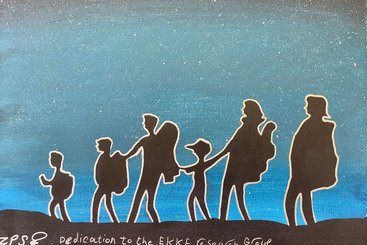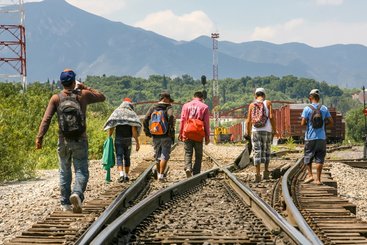Experiences of forced displacement are different for women and men. While these may be positive – such as opening up new opportunities for women in paid work and increased decision-making – they can also be negative, with long-term detrimental effects on women and girls’ opportunities and wellbeing.
As part of our project on forced displacement, which sought to inform effective mechanisms for the integration of social protection programmes and humanitarian assistance, here we share key findings and recommendations for a more gender-responsive and inclusive approach. The findings are drawn from three country case studies – Cameroon, Colombia and Greece – and our thematic papers and toolkits.
Key considerations for a gender-responsive and inclusive response in displacement contexts
Firstly, collecting and analysing data by gender is paramount. Doing so often shows different starting points and outcomes of assistance between refugee, internally displaced person (IDPs) and host households, and further, between female- and male-headed households. For example, we found that people receiving assistance (humanitarian assistance or social protection) generally show higher levels of food security than non-recipients. In some contexts, such as Cameroon, the difference in average food security levels for recipients compared to non-recipients was much larger for female-headed households than male-headed households.
Secondly, for many female-headed households, receiving assistance may be more important and more impactful than for male-headed households. This may be because female-headed households have fewer alternative sources of support and higher levels of vulnerability. In Cameroon, for example, in the IDPs and refugee sample, female-headed households receiving assistance reported much higher levels of satisfaction with their household finances than those not receiving assistance, while for male-headed households the contrast was also evident but much less pronounced. We also find that those receiving assistance tend to report higher levels of satisfaction with their lives in general. In Cameroon and Greece, this finding comes out most strongly for displaced households receiving humanitarian assistance, and the findings are more pronounced when the household head is a woman.
Thirdly, IDP, refugee and host households, and men and women within these households, have diverse experiences in relation to receiving programme information, as well as to programme registration processes and the delivery of assistance benefits. Our findings show that how information on assistance is accessed and received is often different among men and women. Findings from Cameroon show that female respondents in the host community were less likely to have heard of any type of transfer available (governmental or non-governmental) than men. In Colombia, Venezuelan women were more likely than men to hear about government programmes via an advert rather than directly from an organisation, while among host recipients, women were more likely than men to hear about programmes through their personal networks.
Diverse experiences were also reported in the registration and delivery of social protection programme benefits. In Colombia, for example, female-headed households (across displaced and host communities) were more likely to report difficulties in the registration process for receiving assistance related to the fact that the application was online and they did not have access to a laptop or smartphone. Whilst globally, women tend to have lesser access to technology, it is also worth noting that in Cameroon, among the IDP population in our survey (half of whom had mobile wallets), female-headed households were significantly more likely than male-headed households to have mobile account access, and to have set them up to receive assistance.
Finally, although evidence is mixed, we find that female-headed households may face heightened challenges compared to male-headed households in accessing accountability mechanisms. Our research showed overall very limited knowledge and use of complaints processes and grievance mechanisms for social protection or humanitarian assistance by host and displaced populations. Moreover, programme participants rarely held programme providers to account or knew how to seek help formally when problems emerged. We also found that this was often exacerbated for women: female-headed households were less likely to know who to contact with issues (for Venezuelans in Colombia and hosts in Greece) and less likely to feel their complaint was fairly addressed (for hosts in Colombia).
Key recommendations for linking humanitarian assistance and social protection
Our findings point to several recommendations for those working on linking humanitarian assistance and social protection:
- Understand differentiated needs of distinct sub-groups by gender (including hosts vs refugees vs IDPs) in terms of providing context to inform the design and implementation of programmes, and ensure that programme monitoring and evaluation disaggregate by gender at a minimum.
- When considering linking humanitarian assistance and social protection, ensure that these linkages do not jeopardise the provision of adequate support to specific groups with higher – or differential – levels of needs. For example, ensure that the types of assistance and transfer amounts adequately meet both host populations’ and displaced populations’ basic needs, social cohesion and other dimensions of wellbeing, such as girls’ heightened risk of school drop-out, women and girls’ disproportionate care work responsibilities, and violence against women and girls.
- Consider linking programmes with complementary programmes and services to improve wellbeing outcomes for women and girls, and to maximise available resources by increasing coordination among actors serving the intended population.
- Ensure that programme communication mechanisms are tailored to reach both men and women, and that programme implementation and accountability mechanisms are delivered to overcome women and men’s differential barriers to access.
- Work to improve coordination both within and across the humanitarian and social protection systems, and work with gender-focused organisations to help inform and design programmes to meet the different needs and experiences of recipients by gender.



